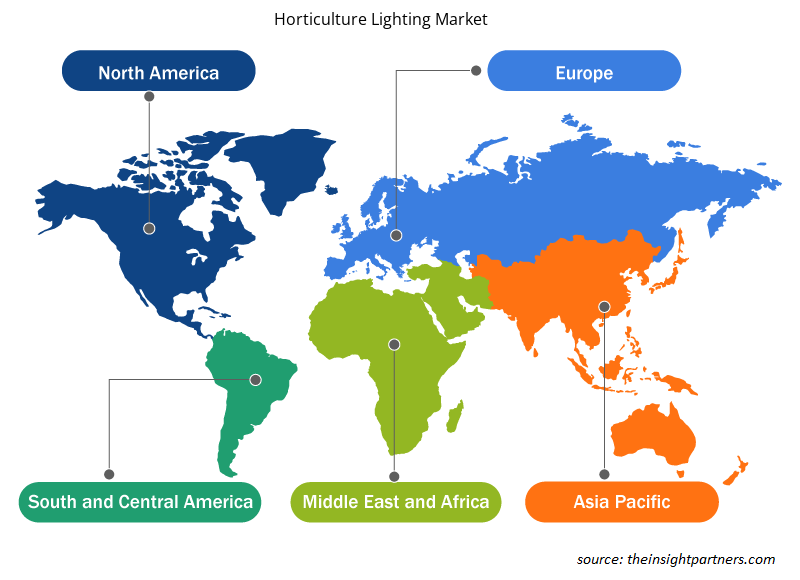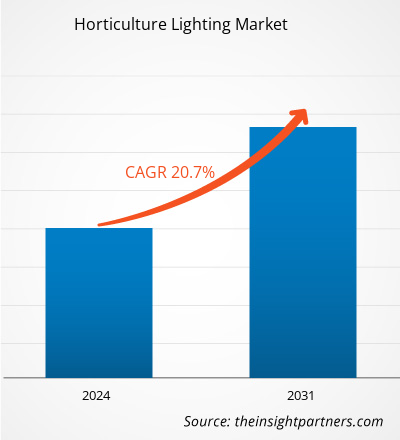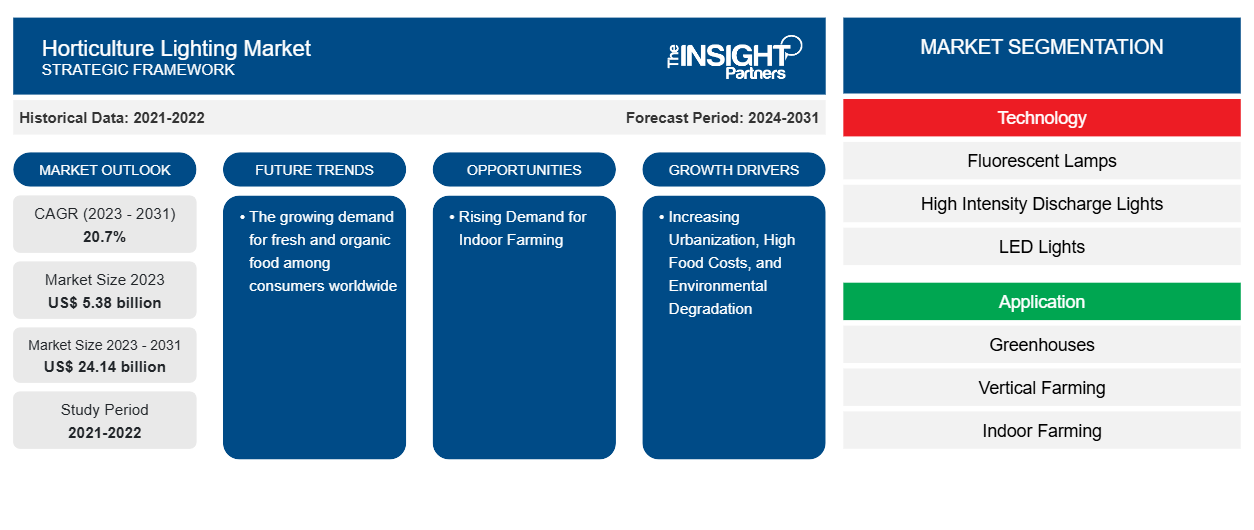Se proyecta que el tamaño del mercado de iluminación para horticultura alcance los 24.140 millones de dólares estadounidenses en 2031, frente a los 5.380 millones de dólares estadounidenses en 2023. Se espera que el mercado registre una CAGR del 20,7 % entre 2023 y 2031. Es probable que la creciente demanda de alimentos frescos y orgánicos entre los consumidores de todo el mundo siga siendo una tendencia clave en el mercado de iluminación para horticultura.
Análisis del mercado de iluminación para horticultura
El mercado de la iluminación para horticultura está creciendo a un ritmo rápido debido a la creciente urbanización, los altos costos de los alimentos, la degradación ambiental, la creciente inversión en técnicas de horticultura modernas y la demanda de soluciones de iluminación personalizadas. El mercado se está expandiendo de manera constante, impulsado por la creciente demanda de dispositivos agrícolas energéticamente eficientes y las iniciativas gubernamentales para apoyar la agricultura de interior . Además, la creciente demanda de agricultura de interior y la expansión de la industria de la jardinería doméstica y de bricolaje están brindando oportunidades lucrativas para el crecimiento del mercado.
Descripción general del mercado de iluminación para horticultura
La iluminación para horticultura consiste en el uso de fuentes de luz artificial para ayudar a las plantas a crecer en condiciones controladas, como invernaderos, granjas de interior y cámaras de crecimiento. Estas luces desempeñan un papel fundamental a la hora de proporcionar el espectro, la duración y la intensidad de la luz para simular o aumentar la luz solar natural, mejorando así la fotosíntesis y el desarrollo general de las plantas.
La iluminación hortícola es una técnica importante para aumentar los rendimientos agrícolas, prolongar las temporadas de crecimiento y mantener una calidad constante de las plantas. Las empresas pueden establecer circunstancias óptimas para diversos cultivos utilizando tecnologías de iluminación innovadoras, como los sistemas LED que proporcionan un control preciso de la configuración de la luz, independientemente del clima externo o las limitaciones geográficas. Además, la naturaleza basada en datos de los sistemas de iluminación hortícolas actuales permite a las organizaciones monitorear y modificar las condiciones de iluminación en tiempo real, lo que da como resultado una toma de decisiones y una asignación de recursos mejor informadas.
Personalice este informe según sus necesidades
Obtendrá personalización en cualquier informe, sin cargo, incluidas partes de este informe o análisis a nivel de país, paquete de datos de Excel, así como también grandes ofertas y descuentos para empresas emergentes y universidades.
-
Obtenga las principales tendencias clave del mercado de este informe.Esta muestra GRATUITA incluirá análisis de datos, desde tendencias del mercado hasta estimaciones y pronósticos.
Factores impulsores y oportunidades del mercado de iluminación para horticultura
La creciente urbanización, los altos costos de los alimentos y la degradación ambiental impulsan el mercado
El rápido crecimiento de la urbanización aumenta la producción hortícola para satisfacer la demanda de alimentos, lo que probablemente impulse la expansión del mercado. Además, la falta de agua de riego para las granjas y el aumento de los precios de los alimentos, que están cambiando la preferencia de los agricultores por la horticultura, están impulsando el mercado. Según el Departamento de Agricultura de Estados Unidos, el índice de precios al consumidor (IPC) aumentó un 8,5% en julio de 2022. Este IPC y los precios de los alimentos aumentaron un 1,1% entre junio de 2022 y julio de 2022, mientras que los precios de los alimentos aumentaron un 10,9% en julio de 2021. La creciente demanda de comidas naturales y nutritivas por parte de los consumidores aumenta la oferta de productos hortícolas urbanos. El creciente uso y desarrollo de LED respetuosos con el medio ambiente y energéticamente eficientes en la horticultura para mejorar la producción de los cultivos al reducir el consumo de energía impulsa el mercado durante el período de pronóstico. La organización DesignLights Consortium estima que la optimización de la iluminación hortícola podría ahorrar hasta 240 millones de dólares en electricidad cada año. Esto alienta a los actores del mercado a crear iluminación energéticamente eficiente para aplicaciones de horticultura para satisfacer la creciente demanda de alimentos, impulsando el mercado.U.S. Department of Agriculture, the Consumer Price Index (CPI) rose 8.5% in July 2022. This CPI and food prices climbed by 1.1% between June 2022 and July 2022, while food prices increased by 10.9% in July 2021. Increasing consumer demand for natural and nutritious meals surges the urban horticulture product supply. The increasing usage and development of environmentally friendly and energy-efficient LEDs in horticulture to enhance crop output by reducing energy consumption drives the market during the forecast period. The DesignLights Consortium Organization estimates that horticultural lighting optimization might save up to USD 240 million in electricity each year. This encourages market players to create energy-efficient lighting for horticulture applications to fulfill rising food demand, boosting the market.
Demanda creciente de agricultura de interior: una oportunidad en el mercado de iluminación para horticultura
La creciente demanda de preparar alimentos saludables y nutritivos en casa anima a los consumidores a adoptar técnicas de cultivo en interiores, lo que crea oportunidades en el mercado. La agricultura en interiores se está volviendo más popular en los entornos metropolitanos como respuesta a la escasez de alimentos. Los consumidores de todo el mundo están priorizando el crecimiento del sector de la horticultura para satisfacer las demandas de escasez de alimentos y fomentar las exportaciones hortícolas mundiales. El aumento de las exportaciones hortícolas aumentó la demanda de tecnología agrícola que facilitó las actividades de cultivo en interiores. La introducción de nuevas tecnologías agrícolas, como la iluminación LED utilizada para climas controlados en la agricultura en interiores, generó importantes oportunidades de crecimiento para el crecimiento del mercado durante el período de pronóstico.
Análisis de segmentación del informe de mercado de iluminación para horticultura
Los segmentos clave que contribuyeron a la derivación del análisis del mercado de iluminación para horticultura son la tecnología, la aplicación y el cultivo.
- Según la tecnología, el mercado de iluminación para horticultura se divide en lámparas fluorescentes, luces de descarga de alta intensidad y luces LED. El segmento de luces LED tuvo una mayor participación de mercado en 2023.
- En función de la aplicación, el mercado se segmenta en invernaderos, agricultura vertical y agricultura de interior. El segmento de invernaderos tuvo una mayor participación de mercado en 2023.
- En cuanto al cultivo, el mercado se clasifica en frutas y verduras y floricultura. El segmento de frutas y verduras tuvo una mayor participación de mercado en 2023.
Análisis de la cuota de mercado de la iluminación para horticultura por geografía
El alcance geográfico del informe del mercado de iluminación para horticultura se divide principalmente en cinco regiones: América del Norte, Asia Pacífico, Europa, Medio Oriente y África, y América del Sur/América del Sur y Central.
En términos de ingresos, Europa representó la mayor participación en el mercado de iluminación para horticultura, debido a la presencia de importantes fabricantes de iluminación como Osram Licht AG, Valoya, Gavita y otros. Estos actores se centran en el desarrollo de iluminación energéticamente eficiente y sostenible para su uso en horticultura, lo que se espera que impulse el mercado. Además, países como España, los Países Bajos, Francia e Italia tienen amplias áreas de cultivo en invernaderos. Estos países emplean luces LED para impulsar el crecimiento de plantas para la agricultura de interior. El creciente cultivo de cereales, frutas y verduras para satisfacer la creciente demanda de alimentos en los países europeos aumenta la demanda de iluminación para horticultura para la agricultura de interior, lo que impulsa el mercado.
Perspectivas regionales del mercado de iluminación para horticultura
Los analistas de Insight Partners explicaron en detalle las tendencias y los factores regionales que influyen en el mercado de iluminación para horticultura durante el período de pronóstico. Esta sección también analiza los segmentos y la geografía del mercado de iluminación para horticultura en América del Norte, Europa, Asia Pacífico, Oriente Medio y África, y América del Sur y Central.

- Obtenga datos regionales específicos para el mercado de iluminación para horticultura
Alcance del informe de mercado de iluminación para horticultura
| Atributo del informe | Detalles |
|---|---|
| Tamaño del mercado en 2023 | 5.380 millones de dólares estadounidenses |
| Tamaño del mercado en 2031 | US$ 24,14 mil millones |
| CAGR global (2023 - 2031) | 20,7% |
| Datos históricos | 2021-2022 |
| Período de pronóstico | 2024-2031 |
| Segmentos cubiertos |
Por tecnología
|
| Regiones y países cubiertos |
América del norte
|
| Líderes del mercado y perfiles de empresas clave |
|
Densidad de actores del mercado: comprensión de su impacto en la dinámica empresarial
El mercado de iluminación para horticultura está creciendo rápidamente, impulsado por la creciente demanda de los usuarios finales debido a factores como la evolución de las preferencias de los consumidores, los avances tecnológicos y una mayor conciencia de los beneficios del producto. A medida que aumenta la demanda, las empresas amplían sus ofertas, innovan para satisfacer las necesidades de los consumidores y aprovechan las tendencias emergentes, lo que impulsa aún más el crecimiento del mercado.
La densidad de actores del mercado se refiere a la distribución de las empresas o firmas que operan dentro de un mercado o industria en particular. Indica cuántos competidores (actores del mercado) están presentes en un espacio de mercado determinado en relación con su tamaño o valor total de mercado.
Las principales empresas que operan en el mercado de iluminación para horticultura son:
- Agrolux
- Puentelux, Inc.
- Compañía General Electric
- Heliospectra AB
- Hortilux Schrader BV
- Compañía: Hubbell, Inc.
Descargo de responsabilidad : Las empresas enumeradas anteriormente no están clasificadas en ningún orden particular.

- Obtenga una descripción general de los principales actores clave del mercado de iluminación para horticultura
Noticias y desarrollos recientes del mercado de iluminación para horticultura
El mercado de iluminación para horticultura se evalúa mediante la recopilación de datos cualitativos y cuantitativos posteriores a la investigación primaria y secundaria, que incluye publicaciones corporativas importantes, datos de asociaciones y bases de datos. A continuación, se incluye una lista de los avances en el mercado de iluminación para horticultura y las estrategias:
- En junio de 2023, ams-OSRAM AG presentó la quinta generación de su popular LED para horticultura OSLON Square Hyper Red, diseñado para ofrecer un crecimiento más rápido de las plantas y permitir un costo optimizado del sistema. La empresa continúa brindando importantes innovaciones basadas en las sugerencias de los clientes al crear soluciones LED que producen un alto flujo de fotones fotosintéticos (PPF) con mayor eficacia que la generación anterior de LED Hyper Red de 660 nm. El nuevo LED OSLON Square Hyper Red está diseñado para su uso en todas las aplicaciones de iluminación hortícola, incluida la iluminación superior y la iluminación intermedia de invernaderos, la iluminación de fuente única y las aplicaciones de agricultura vertical. (Fuente: ams-OSRAM AG, comunicado de prensa, 2023)
Informe sobre el mercado de iluminación para horticultura: cobertura y resultados
El informe “Tamaño y pronóstico del mercado de iluminación para horticultura (2021-2031)” proporciona un análisis detallado del mercado que cubre las siguientes áreas:
- Tamaño del mercado y pronóstico a nivel global, regional y nacional para todos los segmentos clave del mercado cubiertos bajo el alcance
- Dinámica del mercado, como impulsores, restricciones y oportunidades clave
- Principales tendencias futuras
- Análisis detallado de las cinco fuerzas de Porter y PEST y FODA
- Análisis del mercado global y regional que cubre las tendencias clave del mercado, los principales actores, las regulaciones y los desarrollos recientes del mercado.
- Análisis del panorama de la industria y de la competencia que abarca la concentración del mercado, el análisis de mapas de calor, los actores destacados y los desarrollos recientes
- Perfiles detallados de empresas
- Análisis histórico (2 años), año base, pronóstico (7 años) con CAGR
- Análisis PEST y FODA
- Tamaño del mercado, valor/volumen: global, regional y nacional
- Industria y panorama competitivo
- Conjunto de datos de Excel
Informes recientes
Testimonios
Razón para comprar
- Toma de decisiones informada
- Comprensión de la dinámica del mercado
- Análisis competitivo
- Información sobre clientes
- Pronósticos del mercado
- Mitigación de riesgos
- Planificación estratégica
- Justificación de la inversión
- Identificación de mercados emergentes
- Mejora de las estrategias de marketing
- Impulso de la eficiencia operativa
- Alineación con las tendencias regulatorias























 Obtenga una muestra gratuita para - Mercado de iluminación para horticultura
Obtenga una muestra gratuita para - Mercado de iluminación para horticultura